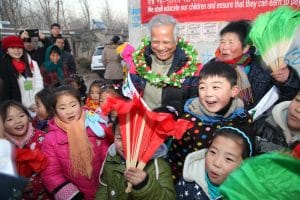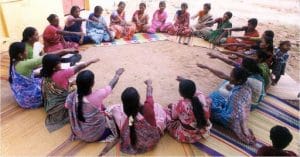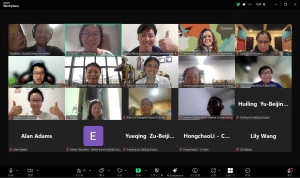Editor’s Note:
Originating from Bangladesh, Grameen Bank has provided millions of small loans to poor individuals all over the world over the years. As radical as it may seem, Grameen Bank has reached 8.4 million people in both developed and less developed countries. Much media coverage of the Grameen Bank so far has put much effort in reporting Grameen’s achievements in the form of numbers, China Development Brief’s (CDB) recent interview with the President & Co-Founder of Grameen China, Gao Zhan, however, pays attention to learning stories about Grameen’s day-to-day work and programmes in the field as well as inviting Gao Zhan to share his own journey with Grameen Bank in exploring ways to help the poor in China.
CDB: Can you share with us your journey with Grameen Bank?
Gao Zhan: My background is sociology and I did not have much knowledge of finance and economics in the past. After graduation, I joined a news agency working as a journalist. But I have always had a strong interest in development issues of rural areas, partly due to the fact that I come from a rural village in northern Jiangsu Province. Initially, I was attracted to some of the interesting segments and concepts of Grameen Bank – for example, in the 16 Decisions [1], the bank asks their clients to build and use sanitary toilets. I was much intrigued and so I started observing Grameen Bank more closely. While commentators in China criticised the model of Grameen Bank and believed it would not fit into the context of China, I quickly realised the bank’s success in other parts of the world, including the richest nation on the earth – the United States. So, I became more determined to figure out if Grameen’s model could work in China and so I quit my previous job and joined the Grameen family.
在陕西安康乡村的格莱珉中心会议上-scaled.jpg)
Mr Gaozhan (fifth from the right side) at a centre meeting in An’kang Village, Shaanxi Province
CDB: How do you understand the key concepts of Grameen Bank proposed by Professor Muhammad Yunus?
Gao Zhan: I think there are three important concepts that are worth paying attention to. First of all, Grameen Bank’s primary focuses are mothers and children, and this has been the case ever since its existence. Professor Muhammad Yunus believes that men, women and children are three groups of people whose needs are distinct from each other. In order to reduce poverty, the young generations must be Grameen Bank’s primary focus. Based on his observation and experiences, Professor Yunus concluded that economic and social benefits can be generated through lending money to women rather than men. According to Yunus, men’s consumption habits are mostly self-centered and women are mostly other-centered, which means when mothers get loans from a financial institution, they would spend a great proportion, if not all, to meet the needs of the whole household, including children, the elderly and their husbands. Loans given to mothers, therefore, are most likely to have the spillover effect: not only women themselves, but also the whole household or even the community will gain benefits. Investing in women, in particular mothers, is actually more of a pragmatic strategy in consideration of social and financial gains rather than a moral duty.
The second key concept is genuine poverty reduction demands efforts to help the poor realise their potential, capabilities and creativity. Yunus argued that everyone is born an entrepreneur and able to use their skills to make ends meet. That is why Grameen Bank does not do philanthropy – our clients have to pay back all their debts with agreed interest. In practice, this concept has been applied to clients’ activities such as group meetings, election of group leaders and peer-assessments.
Another critical concept is community-based activities, which are key to empower women and children as well as fulfil individuals’ potential. The approach adopted by Grameen Bank aims to help build up communities in rural areas, according to local unique culture, customs and context. It is believed that communities can generate both motivation and pressure so that our members will be inspired to work hard and keep their promises of improving their lives and paying back debts. By Grameen’s definition, a community is consisted of small groups of five and a Grameen centre (made up of six to eight small groups). And yet, Grameen’s clients are not legally bonded to their communities. Our loans provided to the poor do not require collaterals, nor do our contracts signed with our clients aim for filing lawsuits in the face of breach of contract. Instead, it is small groups and Grameen centres located in different villages that bind the Bank and its clients together. Through voluntarily forming small groups and attending weekly centre meetings, clients form friendship between each other, they invest their time and gain insights, knowledge and skills from the bank staff and in return, they pay back their loans to the bank with agreed interest rates, mostly higher than the conventional banks.
CDB: How does Grameen Bank identify the population whom you want to help in rural China?
Gao Zhan: Our primary goal is to uplift the poor from poverty, so we will try to find poor people, in particular women who are mothers. However, through my own experience of getting to know people in poverty, I have observed a very interesting phenomenon in rural villages. In one of my fieldworks in Guangdong Province, we surveyed rural poor villagers if they need small loans to develop some business. To our great surprise, the vast majority of the poor population said they did not need any loans for business, despite the fact that they were physically capable and jobless. Our understanding is, their capabilities [to be entrepreneurs] were not sufficiently explored and therefore, they could not see their needs could be fulfilled through microfinance. This understanding has helped us recognise the group of people our programmes aim to target and leave out those who want to take advantage of our loans.
People in real poverty, to my humble knowledge, are people who would not actively reach out for help. There are some people, once heard the Grameen Bank is coming to their village or community, are very eager to approach us and explain to us their business plans and financial needs. Although they may be good entrepreneurs, they are not the people we want to serve. People who we aim to target are normally very timid and slow in response when we talk to them. Luckily, when we try to introduce them with more programme details and our principles, people will gradually show their interest and would like to apply for our loans and abide by our programme rules.

Professor Yunus was visiting Lukou Village, Xuzhou, Jiangsu Province
CDB: Can you share some effective methods Grameen Bank has employed to help the poor in China?
Gao Zhan: A lot of our methods aim to empower people through facilitating them realising their own abilities and rights. For example, we require each group to democratically select their leaders; we ask our members to attend compulsory regular centre and group meetings where people discuss group issues, business issues and sometimes personal issues and mutually seek solutions. Other methods adopted by Grameen Bank are likely to be viewed as “rules,” or modified rules according to local circumstances, but so far, these “rules” seem to work very well with people in need in China.
For instance, one of the requirements of our programmes is involuntary savings, which demands all our clients to save a small amount of money (five percent of the weekly repayment) each time they repay their weekly loans. While “involuntary” may sounds undemocratic, it is clear that our clients are benefiting from this requirement. The most direct result is, they notice the money in their accounts are increasing which enables them to access more resources and make plans for the future. The rationale behind this can be related to a behavioural economics concept proposed by Richard H. Thaler called “mental accounting.” In essence, we guide our clients who normally do not have a habit of saving to learn how to save money. Because the amount of money goes to their saving account is small, many clients would not pay much attention to it in the first place. However, as time goes on, they begin to realise the significance of that saving account: the sum of money in their saving account is growing, sometimes can even exceed the amount of money they borrow from us! Through this involuntary savings approach, we are in fact helping the poor to develop a habit which they can continue to gain benefits, both for now and the future.
Grameen Bank’s mission is to help the conventionally “unbankable” to escape poverty through financial means, and in practice, this is achieved by facilitating the poor to build a community of their own. In this community, Grameen’s loans provide them with financial support; each client’s relationship with other members of the Bank provides them with mental and emotional support; training sessions organised by our staff provide them with skills and life habits which empower them to be more efficient with their own business and lives. The famous 16 Decisions of Grameen Bank are one of our critical guides for community-building, with contents including clients must pay attention to their children’s education, drink clean water and build and use sanitary toilets. Through these alleged mandatory “rules,” we hope to see our clients gradually learning and developing not only skills, but also mindsets and capabilities that can help them well manage their lives and make end’s meet.
CDB: Does Grameen Bank’s microfinance programme in China run very differently in rural and urban settings?
Gao Zhan: The microfinance model of Grameen Bank is elastic, which means it can be adapted to most situations where there is a large quantity of unemployed or inefficiently-employed labour forces and human capital. From Grameen’s perspective, the more unemployed workers there are, the more demands for credit there shall be. These demands in rural and urban areas are essentially the same. The local conditions of a rural village and an urban neighbourhood will be different – if we take the example of Lankao town in Henan Province and an urban neighbourhood in the city of Shenzhen, we realise that in the former setting, our potential clients are mostly local people and in the latter setting, the population is mainly made up of migrant workers. Yet despite the differences, Grameen Bank requires our members in both locations to voluntarily form small groups of five. In either setting, people will naturally choose people whom they trust or at least have very good relationships with.
Some Chinese critics would say once people form small groups and get loans, especially in an urban setting, they might immediately take the money and run away. However, this view has hugely ignored the fact that the small groups are voluntarily formed which has laid good foundation for future activities. Once small groups are formed, the bank will have a five-day training, including practicing savings, electing group leaders and studying Grameen principles, such as the 16 Decisions, where the group members have to involve in all the activities together. If five people have formed a small group not out of trust or good relationships, it is possible the group will not last until the end of the five-day training. And if that unfortunately happens, then no members in this group will get any loans from Grameen Bank.

CDB: What will Grameen China do when your members have been lifted up from poverty? What role does the bank play then?
Gao Zhan: Some of our clients could reach that goal through our programmes in a relatively short period of time, such as in a couple of years, and keep themselves out of poverty thereafter. However, poverty eradication demands a holistic plan to tackle different aspects of people’s lives, and this process takes time and should not be measured by how much time it takes alone.
One of our clients lives in Shenzhen as a migrant worker. Through loans she gained from Grameen China, her and her husband started a small restaurant. Over the years, they managed to run the restaurant pretty well and so their financial situation improved quite a bit. Increased incomes have led them to invest more on their properties, children’s education and family leisure time, yet their business stays on the same scale – they have never expanded their business to other parts of the city, neither do they plan to. In addition, because of the friendships she has built with other members in the Grameen small group, she is now very used to gathering weekly with her friends who are also members in the group. Gradually, the amount of the loans this client applies for from the bank is decreasing, yet her network in Grameen and a sense of “being part of the community” keeps her in the Grameen community.
In Bangladesh, Grameen Bank also has special funds to support individual clients’ small- and medium-sized companies. For example, if one client wants to open his or her own school for training IT technicians. In China, this type of funds is not fully ready to open to our clients, so for the small proportion of our clients who become financially very well-off or even rich, once their schedules become tighter, they may choose to leave the Grameen community and pursue other paths.
Yet one thing we have to emphasise is, Grameen Bank replication programmes across the world are designed to help the poor, reach the poorest among the poor and hope to eventually eliminate poverty. Professor Yunus once said he wished Grameen Bank could soon close all its branches, because when that day comes, it means poverty may no longer be a threat to humanity. In Bangladesh, the number of our clients is still increasing annually. In the United States, we have seen the members of Grameen America rising from 500 to 150,000 within one decade. While we are happy to see the Grameen model is adaptable to the local communities, we are saddened to see an increasing number of people have fallen into poverty.
CDB: How do you envision the future development of Grameen China?
Gao Zhan: In Bangladesh, Grameen Bank operates as a commercial bank and enjoys favourable policies provided by the Bangladeshi government. That means Grameen Bank can legally distribute loans and receive repayment. Apart from microfinance programmes, globally Grameen Bank also pays great attention to transferring and advocating for expertise. In China, Grameen Bank operates differently through a Build-Operation-Transfer (BOT) model in partnership with the China Construction Bank (CCB). Grameen China now has built ten branches across the country, we operate through support from the CCB and all the branches will be transferred to the CCB in due course. At the present time, Grameen China in theory plays a role in facilitating loans distribution of the CCB, but in practice, we are able to apply principles of Grameen Bank in all the activities we organise.
Looking to the future, I hope there will be more acceptance of Grameen Bank’s model and principles in China from different sectors of the society through more thorough research and studies. Over the years, our partnership with the CCB has been robust and I believe in the future it will produce more fruits and attracts more attention in the society. We hope to see more organisations and individuals showing interest to us and work together to create a bank that genuinely serves the poor in China.
Reference:
[1] A set of paternalistic rules central to Grameen Bank’s microfinance programmes, https://grameenbank.org/16-decisions/



